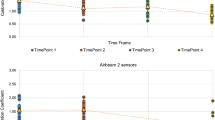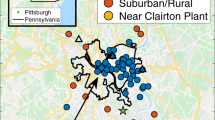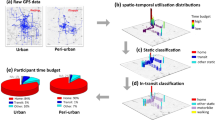Abstract
Rural kitchens of solid-fuel burning households constitute the microenvironment responsible for the majority of human exposures to health-damaging air pollutants, particularly respirable particles and carbon monoxide. Portable nephelometers facilitate cheaper, more precise, time-resolved characterization of particles in rural homes than are attainable by gravitational methods alone. However, field performance of nephelometers must contend with aerosols that are highly variable in terms of chemical content, size, and relative humidity. Previous field validations of nephelometer performance in residential settings explore relatively low particle concentrations, with the vast majority of 24-h average gravitational PM2.5 concentrations falling below 40 μg/m3. We investigate relationships between 24-h gravitational particle measurements and nephelometric data logged by the personal DataRAM (pDR) in highly polluted rural Chinese kitchens, where gravitationally determined 24-h average respirable particle concentrations were as high as 700 μg/m3. We find that where relative humidity remained below 95%, nephelometric response was strongly linear despite complex mixtures of aerosols and variable ambient conditions. Where 95% relative humidity was exceeded for even a brief duration, nephelometrically determined 24-h mean particle concentrations were nonsystematically distorted relative to gravitational data, and neither concurrent relative humidity measurements nor use of robust statistical measures of central tendency offered means of correction. This nonsystematic distortion is particularly problematic for rural exposure assessment studies, which emphasize upper quantiles of time-resolved particle measurements within 24-h samples. Precise, accurate interpretation of nephelometrically resolved short-term particle concentrations requires calibration based on short-term gravitational sampling.
This is a preview of subscription content, access via your institution
Access options
Subscribe to this journal
Receive 6 print issues and online access
$259.00 per year
only $43.17 per issue
Buy this article
- Purchase on Springer Link
- Instant access to full article PDF
Prices may be subject to local taxes which are calculated during checkout


Similar content being viewed by others
References
Allen R., Wallace L., Larson T., Sheppard L., and Liu L.J.S . Estimated hourly personal exposures to ambient and nonambient particulate matter among sensitive populations in Seattle, Washington. J Air Waste Manage Assoc 2004: 54: 1197–1211.
Balakrishnan K., Sambandam S., Ramaswamy P., Mehta S., and Smith K.R . Exposure assessment for respirable particulates associated with household fuel use in rural districts of Andhra Pradesh, India. J Exposure Anal Environ Epidemiol 2004: 14: S14–S25.
Brauer M . Assessment of indoor aerosols with an integrating nephelometer. J Exposure Anal Environ Epidemiol 1995: 5: 45–56.
Brauer M., Bartlett K., Regalado-Pineda J., and Perez-Padilla R . Assessment of particulate concentrations from domestic biomass combustion in rural Mexico. Environ Sci Technol 1996: 30: 104–109.
Brauer M., Hirtle R., Lang B., and Ott W . Assessment of indoor fine aerosol contributions from environmental tobacco smoke and cooking with a portable nephelometer. J Exposure Anal Environ Epidemiol 2000: 10: 136–144.
Chakrabarti B., Fine P.M., Delfino R., and Sioutas C . Performance evaluation of the active-flow personal DataRAM PM2.5 mass monitor (Thermo Anderson pDR-1200) designed for continuous personal exposure measurements. Atmos Environ 2004: 38: 3329–3340.
Day D.E., and Malm W.C . Aerosol light scattering measurements as a function of relative humidity: a comparison between measurements made at three different sites. Atmos Environ 2001: 35: 5169–5176.
Day D.E., Malm W.C., and Kreidenweis S.M . Aerosol light scattering measurements as a function of relative humidity. J Air Waste Manage Assoc 2000: 50: 710–716.
Delfino R.J., Zeiger R.S., Seltzer J.M., and Street D.H . Symptoms in pediatric asthmatics and air pollution: differences in effects by symptom severity, anti-inflammatory medication use and particulate averaging time. Environ Health Perspectives 1998: 106: 751–761.
Delfino R.J., Zeiger R.S., Seltzer J.M., Street D.H., and McLaren C.E . Association of asthma symptoms with peak particulate air pollution and effect modification by anti-inflammatory medication use. Environ Health Perspectives 2002: 110: A607–A617.
Evans J., Wolff S., Phonboon K., Levy J., and Smith K . Exposure efficiency: an idea whose time has come? Chemosphere 2002: 49: 1075–1091.
Ezzati M., Mbinda B.M., and Kammen D.M . Comparison of emissions and residential exposure from traditional and improved cookstoves in Kenya. Environ Sci Technol 2000a: 34: 578–583.
Ezzati M., Saleh H., and Kammen D.M . The contributions of emissions and spatial microenvironments to exposure to indoor air pollution from biomass combustion in Kenya. Environ Health Perspectives 2000b: 108: 833–839.
Gold D.R., Litonjua A., Schwartz J., Lovett E., Larson A., Nearing B., Allen G., Verrier M., Cherry R., and Verrier R . Ambient pollution and heart rate variability. Circulation 2000: 101: 1267–1273.
Howard-Reed C., Rea A.W., Zufall M.J., Burke J.M., Williams R.W., Suggs J.C., Sheldon L.S., Walsh D., and Kwok R . Use of a continuous nephelometer to measure personal exposure to particles during the US Environmental Protection Agency Baltimore and Fresno panel studies. J Air Waste Manage Assoc 2000: 50: 1125–1132.
Jenkins R.A., Ilgner R.H., Tomkins B.A., and Peters D.W . Development and application of protocols for the determination of response of real-time particle monitors to common indoor aerosols. J Air Waste Manage Assoc 2004: 54: 229–241.
Lai A.C.K., Thatcher T.L., and Nazaroff W.W . Inhalation transfer factors for air pollution health risk assessment. J Air Waste Manage Assoc 2000: 50: 1688–1699.
Lanki T., Alm S., Ruuskanen J., Janssen N.A.H., Jantunen M., and Pekkanen J . Photometrically measured continuous personal PM2.5 exposure: Levels and correlation to a gravimetric method. J Exposure Anal Environ Epidemiol 2002: 12: 172–178.
Le Tertre A., Medina S., Samoli E., Forsberg B., Michelozzi P., Boumghar A., Vonk J.M., Bellini A., Atkinson R., Ayres J.G., Sunyer J., Schwartz J., and Katsouyanni K . Short-term effects of particulate air pollution on cardiovascular diseases in eight European cities. J Epidemiol Commun Health 2002: 56: 773–779.
Liu L.J.S., Box M., Kalman D., Kaufman J., Koenig J., Larson T., Lumley T., Sheppard L., and Wallace L . Exposure assessment of particulate matter for susceptible populations in Seattle. Environ Health Perspectives 2003: 111: 909–918.
Liu L.J.S., Slaughter J.C., and Larson T.V . Comparison of light scattering devices and impactors for particulate measurements in indoor, outdoor, and personal environments. Environ Sci Technol 2002: 36: 2977–2986.
McMurry P.H., and Stolzenburg M.R . On the sensitivity of particle size to relative humidity for Los Angeles aerosols. Atmos Environ 1989: 23: 497–507.
Michaels R.A., and Kleinman M.T . Incidence and apparent health significance of brief airborne particle excursions. Aerosol Sci Technol 2000: 32: 93–105.
MIE. Particle Size Dependence of MIE Dust/Smoke Monitors, Rep No. T-2. MIE, Inc.: Bedford, MA., 1990.
Muraleedharan T.R., and Radojevic M . Personal particle exposure monitoring using nephelometry during haze in Brunei. Atmos Environ 2000: 34: 2733–2738.
NBS (National Bureau of Statistics). Zhongguo Tongji Nianjian (China Statistical Yearbook). Zhongguo Tongji Chubanshe (China Statistical Publishing House): Beijing, 2002.
Quintana P.J.E., Samimi B.S., Kleinman M.T., Liu L.J., Soto K., Warner G.Y., Bufalino C., Valencia J., Francis D., Hovell M.H., and Delfino R.J . Evaluation of a real-time passive personal particle monitor in fixed site residential indoor and ambient measurements. J Exposure Anal Environ Epidemiol 2000: 10: 437–445.
Quintana P.J.E., Valenzia J.R., Delfino R.J., and Liu L.J.S . Monitoring of 1-min personal particulate matter exposures in relation to voice-recorded time-activity data. Environ Res 2001: 87: 199–213.
Radojevic M., and Hassan H . Air quality in Brunei Darussalam during the 1998 haze episode. Atmos Environ 1999: 33: 3651–3658.
Rea A.W., Zufall M.J., Williams R.W., Sheldon L., and Howard-Reed C . The influence of human activity patterns on personal PM exposure: A comparative analysis of filter-based and continuous particle measurements. J Air Waste Manage Assoc 2001: 51: 1271–1279.
Richards L.W., Alcorn S.H., McDade C., Couture T., Lowenthal D., Chow J.C., and Watson J.G . Optical properties of the San Joaquin Valley aerosol collected during the 1995 integrated monitoring study. Atmos Environ 1999: 33: 4787–4795.
Salvi S., Blomberg A., Rudell B., Kelly F., Sandstrom T., Holgate S.T., and Frew A . Acute inflammatory responses in the airways and peripheral blood after short-term exposure to diesel exhaust in healthy human volunteers. Am J Respiratory Critical Care Med 1999: 159: 702–709.
Sioutas C., Kim S., Chang M.C., Terrell L.L., and Gong H . Field evaluation of a modified DataRAM MIE scattering monitor for real-time PM2.5 mass concentration measurements. Atmos Environ 2000: 34: 4829–4838.
Smith K.R . Air pollution: assessing total exposure in developing countries. Environment 1988: 30: 17.
Sullivan J.H., Schreuder A.B., Trenga C.A., Liu S.L.J., Larson T.V., Koenig J.Q., and Kaufman J.D . Association between short term exposure to fine particulate matter and heart rate variability in older subjects with and without heart disease. Thorax 2005: 60: 462–466.
Thomas A., and Gebhart J . Correlations between gravimetry and light-scattering photometry for atmospheric aerosols. Atmos Environ 1994: 28: 935–938.
Tian L. Coal combustion emissions and lung cancer in Xuan Wei, China. Doctoral Dissertation, University of California: Berkeley, 2005.
Wallace L . Indoor particles: a review. J Air Waste Manage Assoc 1996: 46: 98–126.
Wallace L.A., Mitchell H., O’Connor G.T., Neas L., Lippmann M., Kattan M., Koenig J., Stout J.W., Vaughn B.J., Wallace D., Walter M., Adams K., and Liu L.J.S . Particle concentrations in inner-city homes of children with asthma: The effect of smoking, cooking, and outdoor pollution. Environ Health Perspectives 2003: 111: 1265–1272.
Wallace L., Williams R., Rea A., and Croghan C . Continuous weeklong measurements of personal exposures and indoor concentrations of fine particles for 37 health-impaired North Carolina residents for up to four seasons. Atmos Environ 2006: 40: 399–414.
Williams R., Suggs J., Zweidinger R., Evans G., Creason J., Kwok R., Rodes C., Lawless P., and Sheldon L . The 1998 Baltimore particulate matter epidemiology-exposure study: Part 1. Comparison of ambient, residential outdoor, indoor and apartment particulate matter monitoring. J Exposure Anal Environ Epidemiol 2000: 10: 518–532.
Wu C.F., Delfino R.J., Floro J.N., Quintana P.J.E., Samimi B.S., Kleinman M.T., Allen R.W., and Liu L.J.S . Exposure assessment and modeling of particulate matter for asthmatic children using personal nephelometers. Atmos Environ 2005a: 39: 3457–3469.
Wu C.F., Delfino R.J., Floro J.N., Samimi B.S., Quintana P.J.E., Kleinman M.T., and Liu L.J.S . Evaluation and quality control of personal nephelometers in indoor, outdoor and personal environments. J Exposure Anal Environ Epidemiol 2005b: 15: 99–110.
Zhang J., Smith K.R., Ma Y., Ye S., Jiang F., Qi W., Liu P., Khalil M.A.K., Rasmussen R.A., and Thorneloe S.A . Greenhouse gases and other airborne pollutants from household stoves in China: a database for emission factors. Atmos Environ 2000: 34: 4537–4549.
Acknowledgements
We thank Katherine Hammond for gracious use of laboratory facilities for weighing filter samples, Wang Guangzhi and Zhang Ziliang for tireless assistance in field research, and the hospitable people of Hechengli village in whose homes we monitored air quality. Thanks for funding extend to the Berkeleyan Graduate Fellowship, the Roselyn Lindheim Award, the UC Toxics Substances Research and Training Program, the National Institutes of Environmental Health Sciences (NIEHS) Superfund Basic Research Training Core Fellowship, Princeton University, and the Wood-Calvert Chair (UCB) in Engineering.
Author information
Authors and Affiliations
Corresponding author
Rights and permissions
About this article
Cite this article
Fischer, S., Koshland, C. Field performance of a nephelometer in rural kitchens: effects of high humidity excursions and correlations to gravimetric analyses. J Expo Sci Environ Epidemiol 17, 141–150 (2007). https://doi.org/10.1038/sj.jes.7500486
Received:
Revised:
Accepted:
Published:
Issue Date:
DOI: https://doi.org/10.1038/sj.jes.7500486
Keywords
This article is cited by
-
Performance assessment of NOVA SDS011 low-cost PM sensor in various microenvironments
Environmental Monitoring and Assessment (2022)
-
Within-microenvironment exposure to particulate matter and health effects in children with asthma: a pilot study utilizing real-time personal monitoring with GPS interface
Environmental Health (2016)
-
Biomass smoke in Burkina Faso: what is the relationship between particulate matter, carbon monoxide, and kitchen characteristics?
Environmental Science and Pollution Research (2014)
-
Validation of continuous particle monitors for personal, indoor, and outdoor exposures
Journal of Exposure Science & Environmental Epidemiology (2011)



